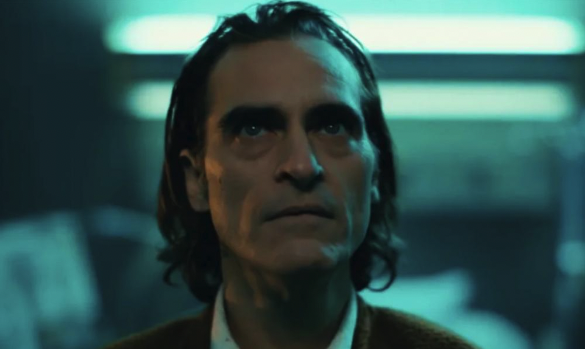A wise man told me that evil never presents itself as what it really is, it disguises itself as virtue. If the purpose of art is to provoke thought, then this is the conclusion that Todd Phillips’ Joker brings to mind. A story about an antisocial, mentally ill character named Arthur who tries to make other people happy but is met with ridicule, so he murders everyone who is mean to him and wins the public’s attention. It is a stupendously gripping psychological drama, an action thriller. The music is captivating; the lighting is masterful; the effects and editing are superb; and the performance — stellar. So why is it that after watching Joker, one is left feeling confused, numb, angry, and even noxious? What was the movie’s point?
When Arthur tries to heal himself, to help others and to pursue his passion, nobody pays any attention. He is only humiliated. In the first half of the film, we are repeatedly shown his emaciated torso symbolic of his weakness and vulnerability. The mise en scène is as colorless and dark as Arthur’s life. The soundtrack is a lone, tense cello. When he starts to kill people, however, we see him gain confidence. Arthur owns his image. He dresses in a nice suit. The scenes become more colorful. The Joker is noticed and feared. Rock & Roll and Sinatra become his soundtrack. Who would not want to feel as high as Arthur?
How one feels after an experience is usually very telling. If the resulting dissatisfaction after watching this blockbuster seems strangely familiar, it is because one feels the same way after eating fast food or drinking alcohol — intoxicatingly gratifying things that ultimately leave one feeling sick and regretful. Of course, the reason why viewers are attracted to Joker is clear, he speaks to the rebel within every individual faced with the maddening injustices of an institutionalized oppressive hierarchy instilled and perpetuated by exclusive, dominant agents who are unconscious of the fact that in an effort to prove themselves superior to others, they have become the very instrument that confirms their inferiority to the system.
But where it becomes confusing is when he crosses the line by committing murder after murder to express his outrage. Admittedly, it is exacerbated by his circumstances but nevertheless, the film disengages the mature viewer because no true rebel would go about instigating change by indulging his wounded ego in such a grisly way. This film is in fact a dangerous, immature fantasy because aspiring rebels, which is the majority of Batman fans, can easily mistake his unconscious actions for courage. There is no meaningful dialogue in crucial moments of the plot. None of the female characters for example deliver a substantial talk that would have rescued the sparse script. Instead, we are left with mindless supporting characters waiting to be moved out of the way for the Joker to emerge with a manic speech, then commit some more murders before running away to the light where the film ends as if it’s trying to declare that violence will prevail against humanity. If this is the point, or rather no point, then what else is on the menu?

A similar type of male fantasy is explored in Riley Stearns’ The Art of Self Defense. Comparing the two movies might bring an insight into the issue at large. Both are dark and graphic comedies. They mock the tragic consequences of the ‘might is right’ type of mentality. However, unlike Joker, Stearns’ movie invites the viewer to examine the problem. Awkwardly but bravely it actually takes a stance. Phillips’ movie is fast and flashy, Stearns’ is deliberate and subtle. Phillips’ movie might seem more attractive at first. However, Stearns’ movie is more worthwhile and thought provoking.
Like Arthur, Casey, the main character in Stearns’ film, is also dutiful and lonely, struggling to find his place in life. When he gets bullied and beaten, Casey signs up to purchase a gun but decides to enroll in karate classes instead. He does everything to become like the accepted role model of masculinity which his teacher, Sensei, seems to embody. But it turns out that Sensei forces his students to hunt for guys like Casey to recruit them to the sect. In a final plot twist, Casey defeats Sensei and by restoring the dignity of the martial art, he comes into his own.
In the Art of Self Defense, the story unravels slowly with progressively growing intensity. The music, the scene-setting and the lights are discrete so as not to distract us from the main story which is delivered by a well-developed script and great performances. The dialogue is comically unemotional. It serves to show how the standard norms of a civilized society are quite often ridiculously inhibiting and how in trying to explain that which is consciously intuited, language can betray the essence of meaning.
Unlike Phillips, Stearns takes the time to show how Casey is feeling conflicted about his awareness of the fact that violence is not a solution to his problem. The solution lies within his own mind. Hence, he chooses a martial art, the primary goal of which is to teach self-discipline and to only engage in physical combat if no other option remains. However, much like in Joker, Sensei misuses karate to perpetuate the popular conviction that violence is power, and kindness is weakness. He forces Casey to adopt this mentality but is ultimately unsuccessful. When Casey defeats his master, the victory is a bit confusing. He goes against his own moral standing and uses Sensei’s own method to defeat him. This is a pivotal moment that is best left to individual interpretation. The moral of the story is that the film ends with a speech from a valuable supporting character who implies that karate is a way, not a tool like a gun, just as humanity is not a tool to be used by the individual but a way to live up to one’s potential.
For Arthur, humanity was an obstacle. For Casey, humanity is the way. Joker’s approach suggests that violence can only be fought with violence. The Art of Self Defense by contrast, shows that violence is fought by cultivating peace within the mind. Arthur might seem sexier at first, but he cannot keep things in perspective. Casey is the one who really attracts the girl in the end, not just because she could have meaningful conversations with the guy, but also because they would both actually still be alive. Upon closer inspection, making mass entertainment out of such a tragic condition as Arthur’s is not cool, it bases Joker on an outdated ideology that turns in on itself. It is like a noisy disturbance. The Art of Self Defense on the other hand, offers an entirely different perspective with many radical components that subvert the status quo. It is part of a 21st century revolution.
By Ariunaa Jargalsaikhan
Published in UB Post on February 3rd, 2020
Ulaanbaatar








